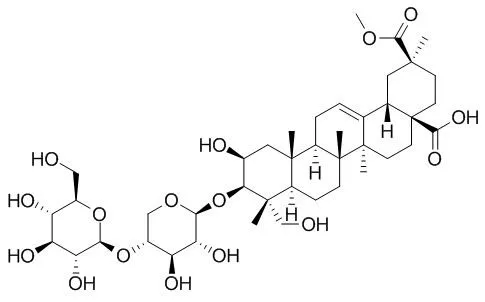| In vivo: |
| J Surg Res. 2013 Nov;185(1):364-72. | | Protective effect of esculentoside A on lipopolysaccharide-induced acute lung injury in mice.[Pubmed: 23764313] | Esculentoside A (EsA) is a saponin isolated from the Chinese herb Phytolacca esculenta. In our study, we sought to investigate the protective effects of Esculentoside A on lipopolysaccharide (LPS)-induced acute lung injury (ALI) in mice.
METHODS AND RESULTS:
To determine the effects of Esculentoside A on the reduction of histopathologic changes in mice with ALI, inflammatory cell count in bronchoalveolar lavage fluid (BALF) and lung wet-to-dry weight ratio were measured in LPS-challenged mice, and lung histopathologic changes observed via paraffin section were assessed. Next, cytokine production induced by LPS in BALF was measured by enzyme-linked immunosorbent assay. To further study the mechanism of Esculentoside A protective effects on ALI, IκBa, p38, and extracellular signal receptor-activated kinase pathways were investigated in lung tissue of mice with ALI. In the present investigation, Esculentoside A showed marked effects by reducing inflammatory infiltration, thickening of the alveolar wall, and pulmonary congestion. Levels of tumor necrosis factor α and interleukin 6 elevated by LPS were significantly decreased in BALF in Esculentoside A-pretreated ALI model. Furthermore, Esculentoside A significantly suppressed phosphorylation of IκBa, p38, and extracellular signal receptor-activated kinase.
CONCLUSIONS:
Taken together, our results suggest that Esculentoside A suppressed inflammatory responses in LPS-induced ALI through inhibition of the nuclear factor kappa B and mitogen activated protein kinase signaling pathways. Esculentoside A may be a promising potential preventive agent for ALI treatment. | | Arch Med Sci. 2013 Apr 20;9(2):354-60. | | The effect of esculentoside A on lupus nephritis-prone BXSB mice.[Pubmed: 23671449] | Esculentoside A was reported to have the effect of modulating immune response, cell proliferation and apoptosis as well as anti-inflammatory effects in acute and chronic experimental models. However, the effects of Esculentoside A on LN remain poorly understood. To investigate the roles of Esculentoside A in LN, the effects of Esculentoside A were tested on BXSB mice, a SLE model, in which male SB/Le mice and female C57BL/6 mice were hybridized through recombinant inbred species.
METHODS AND RESULTS:
Twenty four BXSB mice were divided into three groups. After 4 weeks, blood samples, urine samples and kidney tissues were collected. Measurement of cytokine levels was carried out using sandwich Esculentoside A reagent kits. Apoptotic scores were obtained with a TUNEL assay. PCNA and Caspase-3 mRNA was detected using the In Situ Hybridization Detection Kit. The results demonstrated that compared with the control group, Esculentoside A administration markedly controlled urine protein excretion, improved renal function, alleviated kidney damage and promoted the apoptosis of glomerular intrinsic cells and renal tubular epithelial cells in animals of the treated group (p < 0.05). Meanwhile, Esculentoside A reduced the serum IL-6 and TNF-α levels (p < 0.05), inhibited the expression of PCNA and promoted the expression of caspase-3, Fas and FasL in animals of the treated group (p < 0.05). The effects of Esculentoside A on BXSB mice were similar to dexamethasone.
CONCLUSIONS:
All these findings indicated that Esculentoside A might play significant roles in the treatment of BXSB mice through modulation of inflammatory cytokines, inhibition of renal cell proliferation and induction of apoptosis. The special targets of Esculentoside A in lupus nephritis are worth further exploration. | | Pharmacology. 1998 Apr;56(4):187-95. | | Esculentoside A inhibits tumor necrosis factor, interleukin-1, and interleukin-6 production induced by lipopolysaccharide in mice.[Pubmed: 9566020] | Esculentoside A, a kind of saponin isolated from the root of the Chinese herb Phytolaca esculenta, is reported to possess potent anti-inflammatory effects in acute and chronic experimental models.
METHODS AND RESULTS:
In the present study, we investigated the effects of Esculentoside A on the production of tumor necrosis factor (TNF), interleukin-1 (IL-1) and interleukin-6 (IL-6) induced by lipopolysaccharide (LPS) in mice. In vitro experiments demonstrated that Esculentoside A (0.1-10 mumol/l) significantly reduced the release of TNF from the peritoneal macrophages derived from mice pretreated with thioglycolate. IL-1 and IL-6 secretion was also obviously inhibited in a concentration-dependent manner by Esculentoside A from 0.01 to 10 mumol/l. In vivo experiments demonstrated that detectable TNF was observed 0.25 h after injection, was maximal at 0.5 h, and returned to baseline at 4 h. Maximal production of IL-1 and IL-6 were observed to be 1 and 2 h, respectively, after injection of LPS. Pretreatment of mice with 5, 10, or 20 mg/kg Esculentoside A once a day for 7 consecutive days dose-dependently decreased the TNF, IL-1 and IL-6 levels in the sera of mice following LPS challenge. TNF, IL-1, and IL-6 are important cytokines involved in the pathogenesis of inflammatory lesions.
CONCLUSIONS:
Inhibition of inflammatory cytokine production may contribute to the anti-inflammatory effects of Esculentoside A. |
|






 Cell. 2018 Jan 11;172(1-2):249-261.e12. doi: 10.1016/j.cell.2017.12.019.IF=36.216(2019)
Cell. 2018 Jan 11;172(1-2):249-261.e12. doi: 10.1016/j.cell.2017.12.019.IF=36.216(2019) Cell Metab. 2020 Mar 3;31(3):534-548.e5. doi: 10.1016/j.cmet.2020.01.002.IF=22.415(2019)
Cell Metab. 2020 Mar 3;31(3):534-548.e5. doi: 10.1016/j.cmet.2020.01.002.IF=22.415(2019) Mol Cell. 2017 Nov 16;68(4):673-685.e6. doi: 10.1016/j.molcel.2017.10.022.IF=14.548(2019)
Mol Cell. 2017 Nov 16;68(4):673-685.e6. doi: 10.1016/j.molcel.2017.10.022.IF=14.548(2019)